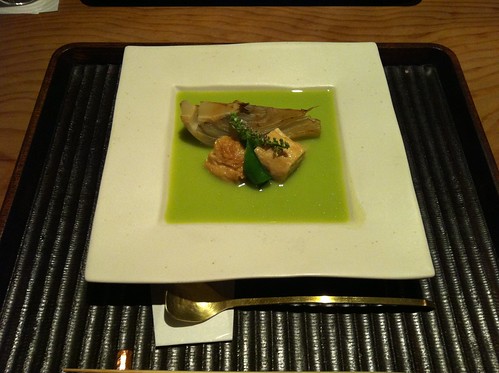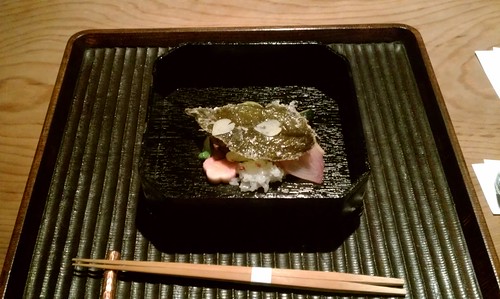
There are a handful of restaurants in New York that I have on what I call, Open Table rotation. Every once in a while I hop on the site and try to score a table. Kajitsu, a vegetarian, japanese restaurant in the East Village, is one of that handful. So, one day when I was trolling the site, I spotted a reservation for Saturday at 6:15pm. I clicked.
Walking down 9th Avenue, a cute block of shops and restaurants between 1st Avenue and A, I was both hungry and excited.There were several reasons for my excitement: Kajitsu is vegetarian (no meat and no fish) and it specializes in kaiseki, which is the Japanese version of haute cuisine. Kasieki is based on shojin cuisine, whose origin is in Zen Buddhism. In its present form kaiseki is a multi-course meal where each component of seasonal ingredients are prepared in ways that enhance the flavor, with the finished dishes beautifully arranged on site-specific pottery. Kajitsu changes its menu every month based on the seasons. I love good, clean food and I love the art of presentation so I went with a good friend and high hopes for a gorgeous meal.
Walking down the small staircase we entered the serene garden-level restaurant and were immediately greeted and ushered into a back room, replete with muted tones of grays and browns, with almost no decoration save for a lone vase on a wall, with one pink-budding branch. There were only three other tables in our room. How novel. Of course, now I know why it took me so long to get a reservation. There are two options on the Kajitsu menu, a four-course or a seven-course menu. Thankfully Blyth, ever the easy going dinner companion, said whichever one you want. Why yes, I said to the Williamsburgy bespectacled waitress, we'll do the seven-course menu–with the sake pairing!
Our waitress, never setting down more than one plate, bowl or sake glass at a time, slowly went over the details of the first course (photo below): spring vegetable sushi with crispy cherry leaf, ginger petal, salted cherry blossom. She went on to tell us that it signified the coming of spring and that the crispy cherry leaf covered the vegetables underneath like a jacket. The vegetables below the "jacket" were crunchy and tangy. The sushi rice was perfect, so perfect it felt like the grains had been seasoned one-by-one. Taking small bites of the crispy leaf on top was a great fatty compliment to the crunchy vegetables. The next course was a grated-cauliflower soup with Rikyu-Fu (wheat protein). The soup was light with nice flecks of cauliflower. I liked that it wasn't whipped or heavy with butter or cream. It stuck to its broth best. The protein in it tasted a bit like a hunk of pumpernickel bread that had sat in the soup long enough for it to be soft but not mushy–it had a nice tug as you bit into it. The next two dishes were interesting and unique, but I'm going to skip ahead to the fifth course (photo above): grilled fennel with yuba and english pea sauce, sugar snap peas, and shiso flower. The dish came in a shallow porcelain plate along with a small golden utensil that looked like small ladle. It also looked like something that belonged on a wall in the Met. The sauce, light enough to be a soup, was light and grassy and the fennel broke apart easily when prodded with the golden spoon. Yuba, the protein in the dish, is the name for the thin skin that forms on the surface of soy milk when it is heated in preparation for making tofu. These ‘skins’ are lifted off as they form and then set out to dry. The yuba in our soup was composed of several layers rolled up tightly to make a chewy, soft bite. Did you know that yuba is so nutritious that it is considered the richest source of protein known (over 52 per cent)? I didn't either.
Between courses we had time to finish off our sake pairings, all individually different. The sake seemed a better accompaniment to the food then wine. Sadly I have no notes on what we drank. We also had time to check out the other tables. There was a couple to my left, he looked like a scientist or an accountant. She was a very pretty asian woman, on first glance I assumed it was an early date (their conversation was meager), but then I realized they were married. These kind of couples really intrigue me, I wondered how they met, what their home life was like, if she cooked for him while he sat silently reading the paper. The other table, behind us, had four japanese woman laughing and having fun. The table to our right was empty for half our meal. Empty! Again, now I know why it's so hard to make reservations.
Back to the food. Our sixth course was house-made mochi with butterbur (something herbal–a food dictionary would have been handy to have) and scallion mitsuba ankake sauce with nori and ginger. The dish came in a narrow, deep dark stone bowl. Once in front of us we added broth from a stone pitcher and then small squares of seaweed. The dish was warm and hearty and full of so many different textures and tastes. It always impresses me, how japanese cuisine can be so simple yet complex.
Dessert was gomadofu (made from sesame paste, water and kuzu powder) with azuki beans and vegetable chips (two pieces of lotus root and one tiny kumquat). The crunch and taste of the kumquat was so good, I definitely wanted more. The gomadofu–which tastes like a soft tofu and sweet red bean paste combined– was delicious. The portion was a few small bites, just enough to tell your palate you'd had dessert and it was time to go. But wait, there's one more course: tea.
The matcha tea was greener than the greenest grass and tasted like the freshly mown bits that come out of a lawnmower. It had a little froth on top. Alongside it they served three small, rice candies by kyoto kagizen-yoshifus. I discovered that if you placed the rice candy in your mouth and then took a sip of the tea you could invent a new hybrid, and thus sweeter, version in your mouth. A nice little ending to a perfectly complex meal.

No comments:
Post a Comment